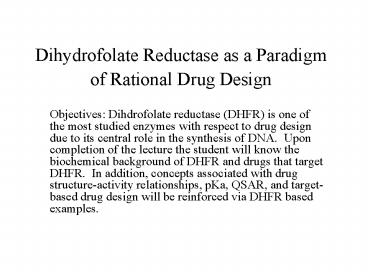Dihydrofolate Reductase as a Paradigm of Rational Drug Design - PowerPoint PPT Presentation
1 / 15
Title:
Dihydrofolate Reductase as a Paradigm of Rational Drug Design
Description:
Dihydrofolate Reductase as a Paradigm of Rational Drug Design ... the steric effect and greater the density, the smaller the steric effect (the ... – PowerPoint PPT presentation
Number of Views:331
Avg rating:3.0/5.0
Title: Dihydrofolate Reductase as a Paradigm of Rational Drug Design
1
Dihydrofolate Reductase as a Paradigm of Rational
Drug Design
- Objectives Dihdrofolate reductase (DHFR) is one
of the most studied enzymes with respect to drug
design due to its central role in the synthesis
of DNA. Upon completion of the lecture the
student will know the biochemical background of
DHFR and drugs that target DHFR. In addition,
concepts associated with drug structure-activity
relationships, pKa, QSAR, and target-based drug
design will be reinforced via DHFR based examples.
2
Methyl donor cycle indicating the essential role
of DHFR in the synthesis of thymine
3
Applications of drugs targeting DHFR
- 1) Anticancer agents
- 2) Antibacterials
- 3) Abortion agent
4
DHFR substrates
- Mechanism of reduction of dihydrofolate to
tetrahydrofolate
5
Structure of dihydrofolate reductase with folate
(red) and NADP (green)
6
Breakdown of dihydrofolate into structural
moieties
7
Inhibitors of DHFR
- amino pteridine
8
QSAR studies on DHFR inhibitors
- Structure of 2,4-diaminoquinazolines and results
from the QSAR analysis - Free and Wilson Indicator variablesI1 1 if
position 2 is a -SH or -OH, 0 if NH2 I2 1 if
position 2 is a H, 0 if NH2 I4 1 if position 4
is a -SH or -OH, 0 if NH2 I5 1 if the following
bridges from position 5 to an aryl group S, SO,
SO2, CH2S, CHCH I6 1 if position 6 is a -SO2Ar
9
Molar refractivity
- Since refractive index doesn't change much for
organic molecules, the term is dominated by the
MW and density. larger MW, larger the steric
effect and greater the density, the smaller the
steric effect (the molecules tend to pack
better).
10
Interpretation of DHFR QSAR
MR positive coefficient indicates favorable
contribution MR squared term allows for
an optimal MR. ? term is based on the
coefficient to the power of ?, as ? increases,
the contribution of that term decreases because
the coefficient is a fraction, however, it is
always favorable. I1 negative -SH or -OH at 2
are unfavorable as compared to NH2 I2 negative
H at 2 is unfavorable as compared to NH2 largest
magnitude coefficient I4 negative -SH or -OH
are unfavorable as compared to NH2 at position 4
I5 negative bridges from position 5 to an aryl
group S, SO, SO2, CH2S, CHCH are unfavorable
I6 positive -SO2Ar at position 6 is favorable
(think about structure of normal substrate) MR6I
negative cross term indicates that the
combination of a -SH or -OH at position 2 and a
large position 6 substituent (due to large MR) is
unfavorable.
11
Structure of Methotrexate bound to Dihydrofolate
Reductase
12
Free energy perturbation calculations on
Trimethoprim and analogs with DHFR
Trimethoprim i) inhibitor of dihydrofolate
reductase ii) ionizable due to N1 of
pyrimidine ring pKa approx. 4 in
solution, therefore unprotonated at physiological
pH N1 protonated when bound to the
enzyme iii) KD subnanomolar
13
Structures of Trimethoprim (TMP) and its p-ethyl
(PET) and tri-ethyl (TET) analogs
14
Thermodynamic cycle applied to trimethoprim (TMP)
and the para-ethyl analog (PET) and related
equilibria and free energy differences
15
Computational data for the binding differences
between TMP and PET and TMP and TET to DHFR
Free energies in kcal/mole































